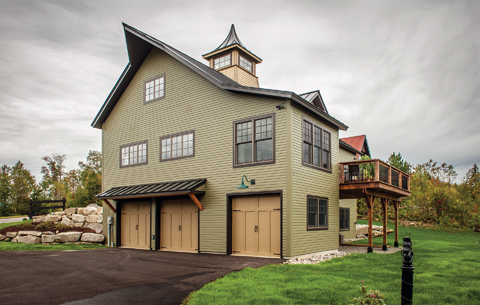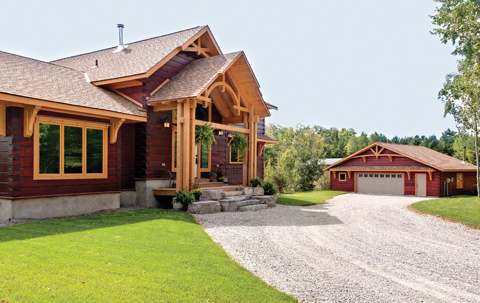Whether you are interested in building the log or timber home you have always wanted or purchasing an existing home, financing is often the most challenging aspect of the experience. The landscape for borrowers and lenders appears to be continually changing, particularly in the wake of the prolonged recession that gripped the global economy for years.
But don’t despair! Financing is available for both construction and purchases. Interest rates are reasonable and remain steady. Banks have money to lend, log and timber home companies offer a broader selection of floorplans and materials than ever before, and builders are busy.
Just like the home itself, however, the financing process requires a firm foundation. The initial step involves determining your budget—getting a feel for what you can afford. Establishing a dialogue with a banking professional that is experienced with log and timber homes helps to get the process started. Although some bankers may shy away from the log and timber home market, others are eager and responsive.
“The market has seen more lenders willing to finance log and timber home projects, but it is typically still limited,” explains Greg Ebersole, an officer with BB&T Home Mortgage. “The best advice for a client is to be proactive in getting prequalified. Additionally, if they have not obtained a mortgage in the past two to three years they should connect with a lender who specializes in log and timber home financing to understand how regulations have affected the loan process.”
Banks and other financial institutions continue to generally offer log and timber home financing at 80 percent of the appraised value of the completed residence, or in the case of a purchase of an existing home the appraised value or sale price—whichever is lower. Once you have considered the price of the home you want to purchase or build, a frank discussion with a lender will bring the rest of the financing process into focus.
“A lender will look at the borrower’s sources of income and their continuing expenses,” says Scott Howell, executive vice president and senior credit officer at Millennium Bank in Chattanooga, Tennessee. “They will also look at how much cash the borrower has available, either for the downpayment on a purchase or the equity needed in a construction project. To close the purchase of a log or timber home, the borrower will need enough cash to cover the difference between the bank’s loan amount and the sale price along with any closing costs that are payable. In a construction project, the borrower needs to have cash or equity in the land where the home is to be built in order to bridge the difference between the approved loan amount, the construction cost, and the value of the finished home.
“And all that assumes that the underwriting process has been completed and the borrower qualifies for the loan based on credit history, a reasonable cushion of disposable income after all monthly expenses—including the new mortgage payment—are covered, and a credit score that is acceptable and generally above 680,” Howell continues. “Your banker can help you estimate the amount of cash or equity needed and provide information on the closing costs the borrower is responsible for paying. These include any origination fee or points charged by the bank, title insurance, survey, recording fees and taxes, and the appraisal.”
Since the housing bubble burst in 2008, a wave of government regulation and enhanced documentation requirements has rippled through the mortgage industry. Ebersole advises his clients to be prepared to provide documentation of income and expense to an even greater degree in the form of income tax returns, W-2 forms, a current personal financial statement, and bank statements that reflect sufficient cash balances to support the mortgage transaction. “Everything has to have documentation to support the uniqueness of the borrower’s qualifying process,” he says. “The only advice that has changed since the mortgage meltdown is that the client needs to be prepared for more documentation.”

Yankee Barn Homes
Construction financing presents additional requirements. Borrowers must provide plans for the log or timber home to be built, a specification sheet listing materials to be used, and a thorough cost estimate so that an appraiser is able to determine a value on completion. Additional appraisal concerns relate to the identification of comparable sales of homes of similar construction and in the same price or cost range. Since these may be difficult to find, the more equity a borrower can put into the project the greater the flexibility in loan to value.
Some package producers may also require at least half the cost of the necessary logs or timber up front, prior to the delivery of any materials to the building site. This situation requires cash from the borrower or a lender who understands the process and is willing to advance funds under such conditions.
While many banks continue to offer construction-permanent financing, which involves one loan closing that converts to an amortizing structure after the home is completed, others may offer only separate construction and permanent loans that will require two closings. Ask your banker about the availability of the construction-permanent program and check into the requirements for locking an interest rate in at the time of the loan application.
According to Andrew West, a wealth management adviser with the Mounier, Larson, West & Gasparini Group in Rockford, Illinois, many borrowers have found that log and timber home financing is accomplished more easily through a local community bank rather than a regional or money center bank. West also offers alternative methods of financing to his clients, avoiding the traditional construction loan. A number of major banks have actually closed their construction lending departments in response to the increased costs of the regulatory burden that has developed since the recession.
“Most big banks have suspended construction-permanent loans,” West offers. “They have opted to let the local banks do it. This is the same direction that loans for building lots went several years ago. The greatest concern for log or timber home clients is getting the construction done. Once the home is finished, permanent financing is no problem. Appraisals are good. The value is there.”
So what solutions does West offer to clients?
“I look at other items, “ he advises. “The work-around is an equity loan on an existing home or business, or anything that is more efficient and less difficult than a construction loan these
days. We can loan on other assets that a borrower may have, such as marketable securities or cash accounts.“
Still, West cautions his clients to closely monitor the progress of their home’s construction even if the funds are secured by other assets and there is no formal construction agreement with the lender. “I encourage inspections. Stick to your budget. If you are not near the construction site, hire someone who is nearby, someone you can trust to oversee the project.”
An array of financing options is available for prospective log or timber homeowners. Starting out with a budget in mind and the help of a professional eases the process.

